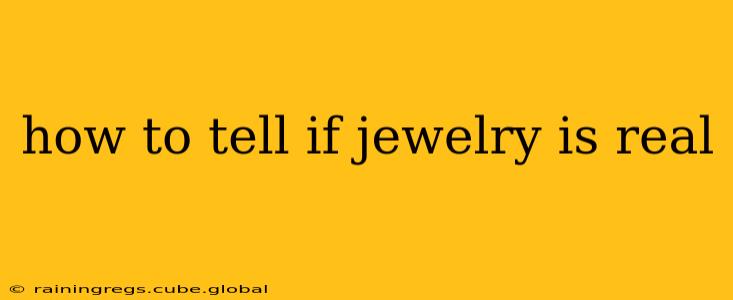Determining whether your jewelry is genuine can be tricky, especially with the abundance of imitations on the market. This guide provides a comprehensive overview of methods to help you authenticate your precious pieces, from simple at-home tests to professional appraisal. Whether you're a seasoned collector or a curious newcomer, understanding how to distinguish real jewelry from its counterfeits is essential.
What are the hallmarks of real gold and other precious metals?
One of the first things to look for is the hallmark. Genuine jewelry, particularly gold and platinum pieces, often bears a hallmark – a small stamp indicating the metal's purity and possibly the maker's mark. These hallmarks vary by country, so research the markings typical for the jewelry's suspected origin. For example, the hallmark for 18k gold will differ in the UK compared to the US. The absence of a hallmark doesn't automatically mean it's fake, as some antique pieces or smaller manufacturers may not have used them, but it’s a strong indicator to consider.
How can I test gold jewelry at home?
Several at-home tests can offer preliminary insights into the authenticity of gold jewelry. However, remember these are not definitive tests and should not replace professional appraisal for high-value items.
The Acid Test:
This involves using a gold testing stone and acid. A small scratch from the jewelry is made on the stone, and a drop of acid is applied. The reaction of the metal to the acid can indicate the karat of the gold. This method requires careful handling and knowledge of the proper acid to use. Incorrect application can damage the jewelry. It's best to consult a jeweler who is experienced in using this method.
Magnet Test:
Gold is not magnetic. If your jewelry is strongly attracted to a magnet, it's likely not pure gold. However, some gold alloys might exhibit slight magnetic properties, so this test is not conclusive.
How do I tell if my silver jewelry is real?
Similar to gold, silver jewelry may also have hallmarks indicating its purity (often marked as sterling silver, 925, or .925). Look for these markings.
The Vinegar Test:
Submerging silver in white vinegar for a few hours is sometimes suggested. Real silver should show minimal to no discoloration, while plated silver may tarnish more quickly. Again, this test is not foolproof.
What about diamonds? How can I tell if a diamond is real?
Diamonds possess unique optical and physical properties.
The Fog Test:
A real diamond will not fog when you breathe on it; the moisture will dissipate almost instantly. However, this is a very unreliable test, easily fooled by skilled imitations.
The Sparkle Test:
Diamonds have a distinctive brilliance and sparkle that is often difficult to replicate. Look for a bright, fiery sparkle that doesn't look dull or glassy. This is subjective, however, and better assessed by a professional gemologist.
Professional Diamond Testing:
For high-value diamonds, it is crucial to seek professional verification. Gemological laboratories use advanced equipment, including magnification, spectroscopy, and thermal conductivity tests, to confirm a diamond's authenticity and grade.
What is a jeweler's opinion worth?
A reputable jeweler can provide a valuable assessment of your jewelry. They often have experience identifying hallmarks, testing metals, and evaluating gemstones. Their opinion, while not a legally binding appraisal, adds significantly to the confidence in the authenticity of your pieces.
What if I suspect my jewelry is fake?
If you have doubts about the authenticity of your jewelry, don't hesitate to seek professional assistance. A gemologist or appraiser can perform comprehensive tests and provide a detailed report on the materials used. This is especially recommended for high-value pieces or those with significant sentimental value.
What are some common signs of fake jewelry?
- Unusually low price: If a deal seems too good to be true, it probably is. Precious metals and gemstones come at a cost.
- Poor craftsmanship: Examine the piece carefully for uneven settings, scratches, or rough edges. Genuine jewelry usually showcases superior craftsmanship.
- Lack of hallmarks: While not always definitive, the absence of hallmarks should raise questions, especially on pieces that should have them.
- Unusual weight: Genuine gold and platinum are considerably heavier than their imitations. If a piece feels surprisingly lightweight for its size, it might be a counterfeit.
Remember, while at-home tests can offer preliminary clues, they are not definitive. For valuable pieces, always consult a trusted jeweler or gemologist to ensure accurate authentication. Professional appraisal provides the most reliable confirmation of your jewelry's authenticity and value.
